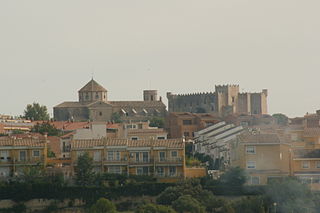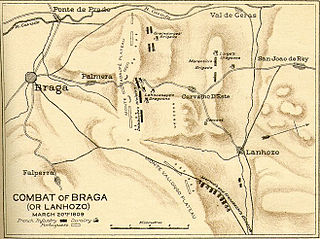
The Battle of Uclés saw an Imperial French corps led by Marshal Claude Perrin Victor attack a Spanish force under Francisco Javier Venegas. The French easily crushed their outnumbered foes, capturing over half of the Spanish infantry. Uclés is located in the province of Cuenca 15 kilometres (9.3 mi) east of Tarancón and 100 kilometres (62 mi) southeast of Madrid. The action occurred during what is called the Peninsular War in English-speaking countries and the Spanish War of Independence in Spain. The war was part of a larger struggle known as the Napoleonic Wars.

The Battle of Ocaña was fought on 19 November 1809 between French forces under Marshal Soult and King Joseph Bonaparte against the Spanish army under General Aréizaga, which suffered its greatest single defeat in the Peninsular War.

Theodor von Reding was a Swiss mercenary who served in the Spanish Army. He was a governor and military commander in Spain during the French Revolutionary Wars and the Peninsular War.
In the Peninsular War, the Battle of Medellín was fought on 28 March 1809 and resulted in a victory of the French under Marshal Victor against the Spanish under General Don Gregorio Garcia de la Cuesta. The battle marked the first major effort by the French to occupy Southern Spain, a feat mostly completed with the victory at the Battle of Ocana later in the year.
The Battle of María saw a small Spanish army led by Joaquín Blake y Joyes face an Imperial French corps under Louis Gabriel Suchet.

In the Battle of Alba de Tormes on 28 November 1809, an Imperial French corps commanded by François Étienne de Kellermann attacked a Spanish army led by Diego de Cañas y Portocarrero, Duke del Parque. Finding the Spanish army in the midst of crossing the Tormes River, Kellermann did not wait for his infantry under Jean Gabriel Marchand to arrive, but led the French cavalry in a series of charges that routed the Spanish units on the near bank with heavy losses. Del Parque's army was forced to take refuge in the mountains that winter. Alba de Tormes is 21 kilometres (13 mi) southeast of Salamanca, Spain. The action occurred during the Peninsular War, part of the Napoleonic Wars.

The siege of Valencia from 3 November 1811 to 9 January 1812, saw Marshal Louis Gabriel Suchet's French Army of Aragon besiege Captain General Joaquín Blake y Joyes's forces in the city of Valencia, Spain, during the Peninsular War. The 20,000 to 30,000 French troops compelled 16,000 Spanish soldiers to surrender at the conclusion of the siege, although another 7,000 Spaniards escaped from the trap. Suchet quickly converted Valencia into an important base of operations after this Napoleonic Wars action. Valencia, modern-day capital of the Valencian Community, is located on the east coast of Spain.

The Battle of Cardadeu on 16 December 1808 saw an Imperial French corps led by Laurent Gouvion Saint-Cyr assault a Spanish force commanded by Juan Miguel de Vives y Feliu and Theodor von Reding. Saint-Cyr won the engagement by forming most of his troops into gigantic attack columns and smashing through the Spanish lines. Cardedeu is located 17 kilometres (11 mi) northeast of Barcelona, Spain. The action occurred during the Peninsular War, part of the Napoleonic Wars.

The Battle of Molins de Rei or Battle of Molins de Rey or Battle of Molins del Rey saw an Imperial French corps led by Laurent Gouvion Saint-Cyr attack a Spanish army temporarily led by Theodor von Reding and the Conde de Caldagues because its commander Juan Miguel de Vives y Feliu was absent. Saint-Cyr outmaneuvered his opponents, distracting them with a false attack in front while sending the bulk of his force across Llobregat River in a turning movement around the Spanish right flank. The Spanish defensive lines crumbled and the French captured 1,200 soldiers, all the Spanish artillery and Caldagues himself. The Peninsular War engagement was fought near Molins de Rei, located 15 kilometres (9 mi) west of Barcelona, Catalonia, Spain.

The siege of Figueras, which lasted from 10 April to 19 August 1811, saw the Spanish garrison of Sant Ferran Castle led by Brigadier General Juan Antonio Martínez defend against an Imperial French force commanded by Marshal Jacques MacDonald and his deputy Louis Baraguey d'Hilliers. Martínez and his men held out much longer than expected but were eventually starved into surrendering the fortress, which was near Figueres. The action occurred during the Peninsular War, part of the Napoleonic Wars.

The Battle of Vich or Battle of Vic on 20 February 1810 saw a Spanish force under Henry O'Donnell suddenly attack a 5,500-man Imperial French division led by Joseph Souham. After bitter fighting the French prevailed, forcing O'Donnell's men to retreat. The engagement occurred during the Peninsular War, part of the Napoleonic Wars. Vic is located 60 kilometres (37 mi) north of Barcelona in the province of Catalonia.
The Battle of El Pla was a battle on 15 January 1811 between an Imperial French column made up of two Italian brigades on one side and a Spanish division under the command of Pedro Sarsfield on the other. The Spanish troops held steady and repulsed the attack of the first brigade, then counterattacked and defeated both brigades. The combat occurred during the Peninsular War, part of the Napoleonic Wars. The action was fought near El Pla de Santa Maria, north of Valls, Catalonia, Spain.

At the Battle of Altafulla, a Spanish division led by Joaquín Ibáñez Cuevas y de Valonga, Baron de Eroles clashed with an Imperial French division under the command of David-Maurice-Joseph Mathieu de La Redorte. Believing he faced only a single battalion, Eroles attacked in a heavy fog and was beaten by 8,000 French soldiers. The action occurred during the Peninsular War, part of the Napoleonic Wars. The battle was fought near Altafulla, 10 kilometres (6.2 mi) northeast of Tarragona, Catalonia, Spain.

The Battle of Braga or Battle of Póvoa de Lanhoso or Battle of Carvalho d'Este saw an Imperial French corps led by Marshal Nicolas Soult attack a Portuguese army commanded by Baron Eben. When Soult's professional soldiers attacked, the Portuguese at first fought back but soon ran away. The French slaughtered large numbers of their opponents, who were mostly badly disciplined and poorly armed militia. The action was part of the second invasion of Portugal, during the Peninsular War.

The Battle of Alcántara saw an Imperial French division led by Marshal Claude Perrin Victor attack a Portuguese detachment under Colonel William Mayne. After a three hours skirmish, the French stormed across the Alcántara Bridge and forced the Portuguese to retreat. The clash happened during the Peninsular War, part of the Napoleonic Wars. Alcántara, Spain is situated on the Tagus river near the Portuguese border, 285 kilometres (177 mi) west-southwest of Madrid.

The Battle of Arzobispo on 8 August 1809 saw two Imperial French corps commanded by Marshal Jean-de-Dieu Soult launch an assault crossing of the Tagus River against a Spanish force under José María de la Cueva, 14th Duke of Alburquerque. Alburquerque's troops rapidly retreated after suffering disproportionate losses, including 30 artillery pieces. El Puente del Arzobispo is located 36 kilometres (22 mi) southwest of Talavera de la Reina, Spain. The action occurred during the Peninsular War, part of a larger conflict known as the Napoleonic Wars.

The siege of Mequinenza saw a 16,000-man Imperial French corps commanded by Louis Gabriel Suchet invest a 1,000-strong Spanish garrison under Colonel Carbon. Mequinenza and its castle were captured by the French after an operation lasting about three weeks. The action occurred during the Peninsular War, which formed part of the Napoleonic Wars. Mequinenza is located at the confluence of the Ebro and Segre Rivers about 211 kilometres (131 mi) west of Barcelona.
Jean-Baptiste Salme or Salm led French troops in several actions during the French Revolutionary Wars and Napoleonic Wars. Several times he landed in trouble by associating with the wrong people, including his wife who tried to kill him. He served alongside Jacques MacDonald when they were both generals of brigade in the Flanders Campaign in 1794. Still commanding only a brigade, he served in MacDonald's army in Italy during 1799 and in Spain during 1810.

Giuseppe Federico Palombini or Joseph Friedrich von Palombini became an Italian division commander during the Napoleonic Wars. He joined the army of the Cispadane Republic in 1796 and fought at Faenza in 1797. He became commander of a dragoon regiment in 1798. He became commander of the Napoleone Dragoons, of the Cisalpine Republic army, in 1802. He fought as an ally of the French at Kolberg and Stralsund in 1807. He married the daughter of Jan Henryk Dąbrowski (Dombrowski) in 1806.

The Cardedeu order of battle lists the troops that fought in the Battle of Cardedeu and several other battles fought between June and December in the Spanish province of Catalonia during the Peninsular War. In February 1808, Imperial French forces treacherously seized Barcelona on 29 February and Sant Ferran Castle on 15 March as well as other fortresses in Spain. The Dos de Mayo Uprising broke out when the Spanish people found that Emperor Napoleon deposed the Spanish royal family and set up his brother Joseph Bonaparte as their new king. The 12,000 Imperial French soldiers under Guillaume Philibert Duhesme occupying Catalonia were beaten at the Battles of El Bruch and Gerona in June. Though Duhesme was reinforced by another French division, the Spanish defeated him at the Second Siege of Gerona in July and August. With Duhesme blockaded in Barcelona, Napoleon appointed Laurent Gouvion Saint-Cyr as commander of the VII Corps, added two good divisions and other troops to his force, and ordered him to relieve Barcelona. Saint-Cyr succeeded in this task, winning the battles of Roses, Cardedeu and Molins de Rei in December.























